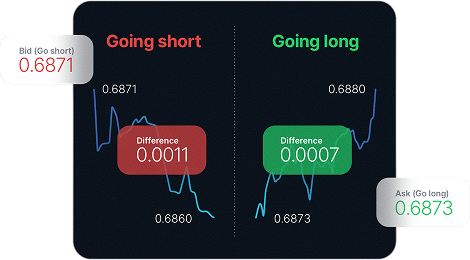| AUDCAD |
Australian Dollar vs Canadian Dollar |
- |
1.9 |
0 |
1.1 |
| AUDCHF |
Australian Dollar vs Swiss Franc |
- |
1.9 |
0 |
0.8 |
| AUDJPY |
Australian Dollar vs Japanese Yen |
- |
1.9 |
0 |
0.8 |
| AUDNZD |
Australian Dollar vs New Zealand Dollar |
- |
1.7 |
0 |
0.9 |
| AUDSGD |
Australian Dollar vs Singapore Dollar |
- |
3.2 |
0 |
1.7 |
| AUDUSD |
Australian Dollar vs US Dollar |
- |
1.4 |
0 |
0.3 |
| BWPUSD |
Botswanan Pula vs US Dollar |
- |
1.8 |
1.1 |
1.8 |
| CADCHF |
Canadian Dollar vs Swiss Franc |
- |
1.6 |
0 |
0.8 |
| CADJPY |
Canadian Dollar vs Japanese Yen |
- |
1.7 |
0 |
0.6 |
| CHFJPY |
Swiss Franc vs Japanese Yen |
- |
2.2 |
0 |
1.1 |
| CHFSGD |
Swiss Franc vs Singapore Dollar |
- |
4.3 |
0 |
3.2 |
| EURAUD |
Euro vs Australian Dollar |
- |
2.3 |
0 |
1.2 |
| EURCAD |
Euro vs Canadian Dollar |
- |
3.1 |
0 |
1.4 |
| EURCHF |
Euro vs Swiss Franc |
- |
1.9 |
0 |
0.8 |
| EURCZK |
Euro vs Czech Koruna |
- |
117.7 |
0 |
100.3 |
| EURDKK |
Euro vs Danish Krone |
- |
11 |
1.4 |
5 |
| EURGBP |
Euro vs Great Britain Pound |
- |
1.4 |
0 |
0.3 |
| EURHUF |
Euro vs Hungarian Forint |
- |
121 |
0 |
20.6 |
| EURJPY |
Euro vs Japanese Yen |
- |
1.9 |
0 |
0.8 |
| EURMXN |
Euro vs Mexican Peso |
- |
67.4 |
0 |
47.5 |
| EURNOK |
Euro vs Norwegian Krone |
- |
70.9 |
0 |
63.4 |
| EURNZD |
Euro vs New Zealand Dollar |
- |
3 |
0 |
1.9 |
| EURPLN |
Euro vs Polish Zloty |
- |
21.2 |
0 |
17.9 |
| EURSEK |
Euro vs Swedish Krona |
- |
64.6 |
0 |
59.1 |
| EURSGD |
Euro vs Singapore Dollar |
- |
2.9 |
0 |
1.8 |
| EURTRY |
Euro vs Turkish Lira |
- |
498.3 |
0 |
495.2 |
| EURUSD |
Euro vs US Dollar |
- |
1.2 |
0 |
0.1 |
| EURZAR |
Euro vs South African Rand |
- |
80 |
0 |
68.5 |
| GBPAUD |
Great Britain Pound vs Australian Dollar |
- |
3.5 |
0 |
2.4 |
| GBPCAD |
Great Britain Pound vs Canadian Dollar |
- |
3 |
0 |
1.9 |
| GBPCHF |
Great Britain Pound vs Swiss Franc |
- |
2.7 |
0 |
1.6 |
| GBPDKK |
Great Britain Pound vs Danish Krone |
- |
24.3 |
7.7 |
18.3 |
| GBPJPY |
Great Britain Pound vs Japanese Yen |
- |
2.2 |
0 |
1.1 |
| GBPMXN |
Great Britain Pound vs Mexican Peso |
- |
81.5 |
0 |
61.5 |
| GBPNOK |
Great Britain Pound vs Norwegian Krone |
- |
68.6 |
0 |
61.1 |
| GBPNZD |
Great Britain Pound vs New Zealand Dollar |
- |
3.9 |
0 |
2.4 |
| GBPPLN |
Great Britain Pound vs Polish Zloty |
- |
44.1 |
6.7 |
42.6 |
| GBPSEK |
Great Britain Pound vs Swedish Krona |
- |
115.7 |
0 |
111 |
| GBPSGD |
Great Britain Pound vs Singapore Dollar |
- |
3.2 |
0.3 |
2 |
| GBPTRY |
Great Britain Pound vs Turkish Lira |
- |
765.6 |
110.4 |
758.6 |
| GBPUSD |
Great Britain Pound vs US Dollar |
- |
1.5 |
0 |
0.4 |
| NZDCAD |
New Zealand Dollar vs Canadian Dollar |
- |
2 |
0 |
1.2 |
| NZDCHF |
New Zealand Dollar vs Swiss Franc |
- |
1.6 |
0 |
0.8 |
| NZDJPY |
New Zealand Dollar vs Japanese Yen |
- |
1.9 |
0 |
0.8 |
| NZDSGD |
New Zealand Dollar vs Singapore Dollar |
- |
2.2 |
0.1 |
1.1 |
| NZDUSD |
New Zealand Dollar vs US Dollar |
- |
1.6 |
0 |
0.4 |
| USDBRL |
US Dollar vs Brazilian Real |
- |
35.6 |
10 |
25.6 |
| USDCAD |
US Dollar vs Canadian Dollar |
- |
1.5 |
0 |
0.4 |
| USDCHF |
US Dollar vs Swiss Franc |
- |
1.7 |
0 |
0.6 |
| USDCLP |
US Dollar vs Chilean Peso |
- |
556.5 |
60 |
556.5 |
| USDCNH |
US Dollar vs Chinese Yuan |
- |
1.7 |
0 |
0.6 |
| USDCOP |
US Dollar vs Colombian Peso |
- |
3334.7 |
60 |
3334.7 |
| USDCZK |
US Dollar vs Czech Koruna |
- |
91.2 |
0 |
73.8 |
| USDDKK |
US Dollar vs Danish Krone |
- |
14.5 |
0 |
8.5 |
| USDHKD |
US Dollar vs Hong Kong Dollar |
- |
6.8 |
0 |
5.7 |
| USDHUF |
US Dollar vs Hungarian Forint |
- |
228.1 |
0 |
14.5 |
| USDINR |
US Dollar vs Indian Rupee |
- |
21.8 |
10 |
11.8 |
| USDJPY |
US Dollar vs Japanese Yen |
- |
1.4 |
0 |
0.3 |
| USDKES |
US Dollar vs Kenyan Shilling |
- |
963.6 |
662.4 |
963 |
| USDKRW |
US Dollar vs Korean Won |
- |
80.2 |
10 |
60.3 |
| USDMXN |
US Dollar vs Mexican Peso |
- |
42.7 |
4 |
36.7 |
| USDNOK |
US Dollar vs Norwegian Krone |
- |
64.2 |
0 |
55.7 |
| USDPLN |
US Dollar vs Polish Zloty |
- |
19.5 |
0 |
15.8 |
| USDSEK |
US Dollar vs Swedish Krona |
- |
56.2 |
0 |
47.5 |
| USDSGD |
US Dollar vs Singapore Dollar |
- |
1.9 |
0 |
1.1 |
| USDTHB |
US Dollar vs Thai Baht |
- |
185.2 |
0 |
165.2 |
| USDTRY |
US Dollar vs Turkish Lira |
- |
236.1 |
0 |
233.6 |
| USDTWD |
US Dollar vs New Taiwan dollar |
- |
5 |
2 |
5 |
| USDUGX |
US Dollar vs Ugandan Shilling |
- |
200.8 |
200.8 |
200.8 |
| USDZAR |
US Dollar vs South African Rand |
- |
49.9 |
2 |
39 |















